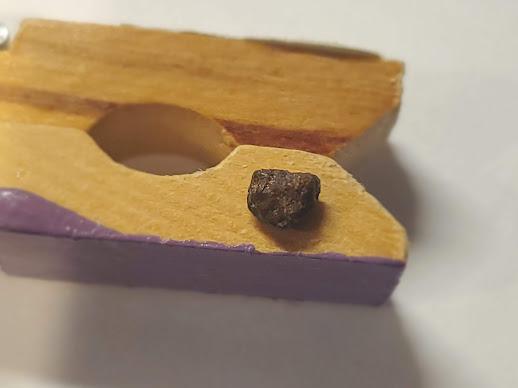I thought I had found some teeny meteorite fragments (see HERE), so I retraced my path along the same stretch of road.
Sure enough, my magnetic walking stick found some more magnetic grains. Some were smaller than before, but one was bigger.
 |
| My most recent space rock candidates with a toothbrush for scale. |
Maybe, I thought, the big one was big enough to grind a little to reveal the interior.
 |
| I'll call this big one "Biggie." |
 |
| I used a nail file to scrape off some of the outer layer. |
The Lunar and Planetary Institute recommends six tests to determine if a rock might be a meteorite. Here are the results on Biggie.
1. Does the sample have a black or brown surface? Yes
2. Is the sample solid, without pores or hollow vesicles? Yes
3. Is the sample heavy for its size? Not sure - too small to tell
4. If a corner of the sample is ground slightly, is the interior metallic silver? Yes - see below!
5. Is the sample unlike other rocks in the area? Yes
6. Is the sample magnetic? Yes
1. Does the sample have a black or brown surface? Yes
2. Is the sample solid, without pores or hollow vesicles? Yes
3. Is the sample heavy for its size? Not sure - too small to tell
4. If a corner of the sample is ground slightly, is the interior metallic silver? Yes - see below!
5. Is the sample unlike other rocks in the area? Yes
6. Is the sample magnetic? Yes
 |
| You can just begin to see a bright silver surface after light scraping. |
 |
| Another view of the silver surface. |
I passed 5 out of 6 tests. Maybe we have a winner? Stay tuned for more info as it becomes available.































